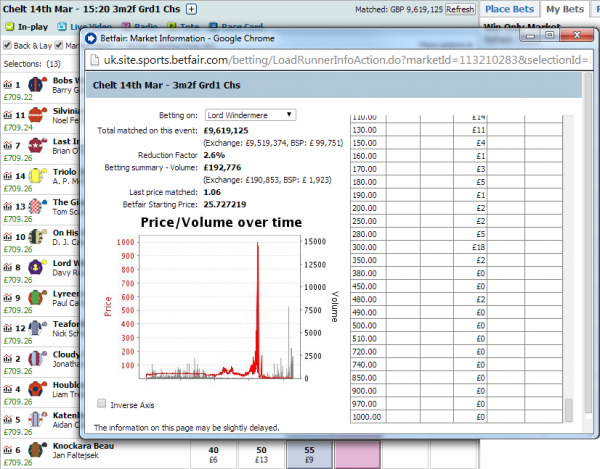Trading Cheltenham

This year I’ve decided to upload a video to narrate some of the stats and detail behind how Cheltenham trades. It seems much easier to express and emphasise points and show a number of things on a video that you can’t do in text. So I’ve created the longest video yet and uploaded it for you!
For those of you that want the text I’ve prepared a long document for you here. It should be of interest one way or the other but why not watch the video as well?
The book over round
Competition is fierce nowadays and this means very little money is lost to either side of the book. On a traditional sportsbook the over-round, the theoretical margin paid to the bookmaker, can be large; but on an exchange this can be tiny. If the over round is 100% then it means that the market was ‘perfect’ and no money was won or lost (before commission) to either side of the book. The closer to 100% you get the more chance you have of winning in the long term as the knowledge gap to overcome the small margin against you is so much smaller.
Over time the number of races that resolve under 100% has been increasing, indicating that the market is getting more and more competitive. It’s been a slightly bumpy ride though. In 2009 we had just one market under 100%, eight in 2010, twelve in 2011, eleven in 2012, just three in 2013 before returning to nine in 2014. Average book SPs from 2014 to 2009 were, 1.8%, 1.7%, 0.5%, 1.9%, 0.5%, 2.78%, respectively. You will lose very little betting on an exchange.
The ‘worst’ SP was 105% but even that was well below what you would get in a ‘normal’ sportsbook. Basically, backing at Cheltenham on a betting exchange is fantastic value for money.
The favourites
In total around 50% of all money matched on the markets is on the favourite. 2014 was a below average year for favourites and we saw just 22% of them win their respective races, this was below the long term average of 26%. But the average SP was lower so in fact backing favourites last year would have left you net positive overall. In the last six years, as the markets have become more competitive, just backing the favourites would have yield a profit in the last four. There is a catch though, you need to use proportional staking, not level staking. If you want to know how, read on.
Where the winners came from
If we rank the runners from favourite to least favourite we can examine where in the field the winners generally came from. Over a quarter of the time the favourites were declared winners. It’s not until get past the eighth favourite that the number of winners declines significantly. But looking in the front eight gets you a winner 80% of the time. You need to be a bit luckier beyond the front eight.
Best strategy for backing big priced winners or more than one runner
Dutching is a neat way of spreading your risk when trying to pick a winner on an exchange. Rather than using level stakes dutching allows you to spread you risk and profit across more than one runner in the field.
Picking one winner from 28 is tough, especially in a competitive handicap. But ‘dutching’ allows you to winners from a range of selections in a market ensuring you have a better chance of a profiting. If we expand our focus from picking one winner to picking one from a number of selections, things look up a bit.
When ‘dutching’ you flip traditional betting on its head. When placing a traditional back bet you simply choose a stake and place a bet at the best available odds. When ‘dutching’ instead of putting £10 on something at 16’s, you nominate how much you would like to win then pick a number of selections that you think could win. Once you have made your selections, the dutching tool in Bet Angel will do some clever maths to work out how to achieve your bet and will give you the stake required to achieve your objective. In a ten runner field, for example, you may want to win £10 by picking any five runners to win. Once you make your selections you just click the ‘place bet’ button and Bet Angel takes care of the rest.
You can go a step further on Bet Angel than traditional dutching tools by nominating your profit by runner. So it’s possible to construct a back bet that says something along the lines of, ‘I want to win £50 if the favourite wins, break even on the second favourite, lose £5 if the third comes in and I want to win £20 on the next three’. This gives you huge flexibility on finding a winner and more importantly, on your terms. Given the low over-round available on exchanges it’s a great way of picking a winner.
The real in dutching comes from find a big price runner. As long as you don’t go mad then there are some big priced winners to be found in the competitive races. If you dutched runners ranked 7-18 you would have made money in all but one of the last six years. Just blindly the back of the book from runners ranked 10 and upwards wouldn’t have worked, so it’s that middle division that is a good place to look to unlock value at Cheltenham.
What worked in-running?
The in-running markets produced their usual slice of interest. Winners came from 95, 480 and a whopping 1000 in running to win; Western Warhorse providing the big price. The general rule of thumb at Cheltenham is that short prices really need to be out of contention to drift significantly. They do tend to drift anyway, just not significantly. Laying to back is a little riskier at shorter prices at Cheltenham. Bigger prices that perform well in-running tend to shorten pretty quickly and that is where you should be looking. The average high price the favourite traded at in-running was 41 in 2013, 30 in 2012 and 45 in 2011.
It’s interesting to see the winner of the Gold Cup last year romped home having traded at 300 last year, in fact it traded slightly higher but on tiny money. Of course, having traded it pre off I just watched the race any how. But it was an interesting market of note.
Best strategy for laying the field in-running
Another area to explore in-running is to lay the field. It’s a really simple strategy to deploy. You type in a price you want to lay at in Bet Angel and then click, ‘Lay all’. The general rule of thumb here is that to break even you need to lay X runners at X odds. If you select digital odds of 2, you need to lay 2 runners at 2 to break even. Three runners at 3’s will break even and so on.
Last year at Cheltenham there were 21 races where a runner traded at or under evens in-play and still lost the race. When laying the field though it’s not about the lowest price reached, but more about how many runners trade below certain levels in running. In 2014 49 runners traded at or below 3.00 and still lost. Over the last six years we have generally found near 50 runners achieve this feat. Only three races last year had two runners trade under 2.00 and lose, 2013 was the same but 2012 was all fun and games with nine such races. Other years the market gravitates to smaller values. The in-running market is far more certain at Cheltenham.
Of course things can change depending on how the race pans out and if there is an early faller. But for that reason I suggest you try arming your lay the field target price and await an opportunity during the race. For lay the field in-running to work you ideally really need a competitive race with a close finish where the lead is uncertain in the final part of the race. Up until that point it’s more about staying in the race.
My trading approach
I tend to use Tuesday as a day to test out strategies and examine how the market is ‘behaving’. From a trading perspective, you can never be totally sure what you are about to face. As year passes you often pick up subtle shifts in the market. So the start of the week is the opportunity to learn, quickly, how the markets are behaving this year. From there it’s about putting your foot down with some confidence.
BETDAQ prices track Betfair prices very closely and their charges are much lower. Based on my experience in prior year, the markets on BETDAQ are very favourable in comparison to Betfair in terms of asking for a price and getting it. This is because there is generally less money waiting to be matched. I suggest you have both exchanges at the ready. We recently upgraded BETDAQangel to look and feel very familiar to your Betfiar tool. So it’s the perfect opportunity to give it a good run out!
Because of the amount of money being traded at Cheltenham, volatility by tick prices are naturally lower. In fact I can give you some exact numbers. It is 33% below what you see in a ‘normal’ market. Obviously the amount of money at Cheltenham is much higher than a ‘normal’ market and this leads to a slower fill rate on money offered to the market. Over the years this has got bigger and bigger and reached nine times normal activity in 2014. In short it can take an age to get your order filled. That increases your trading risk but the lower volatility offsets that somewhat. If you switch to Betdaq this has historically run at four times normal and therein lies one key aspect of Cheltenham that is intriguing. It can often be better to use BETDAQ than Betfair.
Summary
There are many things that can work quite well at Cheltenham. Hopefully I’ve given you some clear pointers in this article.
Don’t forget you can deploy these strategies with ease or even fully automatically using Bet Angel. We have a practice mode so you can test ideas or the many tools inside the software completely risk free. We also have a completely free version for you if you are using BETDAQ and free dutching software.
So all I have to do now is wish you the best of luck, I can’t wait to hear that Cheltenham roar!
![]()
Category: Horse Racing, Trading strategies






